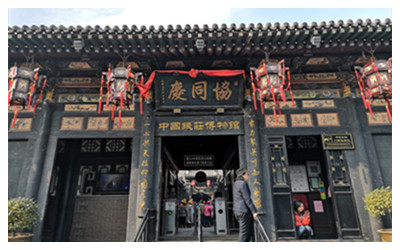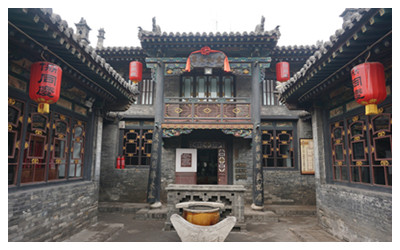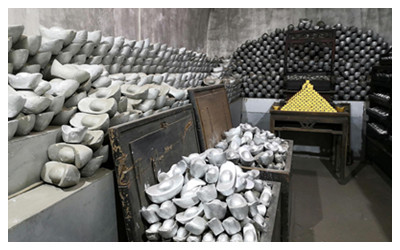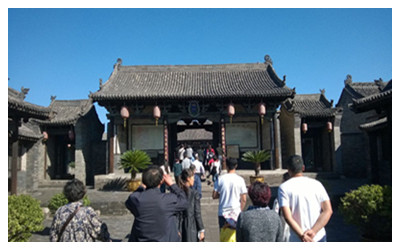
Xietongqing Ancient Bank, an unincorporated bank in ancient Pingyao, was founded in 1856 and closed in 1913. In 2000, it was restored and became Xietongqing Ancient Bank Museum, showing visitors what an ancient bank looked like.
The Unincorporated Bank is an early form of modern bank. In the
Qing Dynasty (1644 - 1911 AD), Pingyao was very prosperous and once became the commercial and financial center of China. Therefore, a large amount of currency came in and out very day. Currency at that time consisted of heavy coins, silver and gold, inconvenient and unsafe for transport. Unincorporated banks then appeared. Businessmen stored their money in one of the many branches of an unincorporated bank and got a receipt. After traveling light to their destinations, they could get their money back with the receipt at the local branch of that unincorporated bank. The unincorporated banks also provided loan service.
Xietongqing Ancient Bank was the largest of its time, with 33 branches spread not only in China, but also in Japan, Russia and Southeast Asia. Its headquarter in Ancient City of Pingyao encompasses 7 courtyards with an area of 2,800 square meters.
 Courtyard 1:
Courtyard 1: Bank Hall
It has 2 counting rooms in the south and north. Small deposits and withdrawals were dealt with were dealt here.
Courtyard 2: VIP Room, Financial Room & Mails Room
One of the rooms in this courtyard is the financial room where business calculation of branches and headquarter was done. Another room was used to receive and send business mail. One interesting thing is that the salary of the staff in mail room was very high, about 4 times that of the magistrate of Pingyao County. This was because they edited the code for money deposits and withdrawals on the receipts, which was the highest secret of the unincorporated bank. Just like todays’ banks, VIPs were received separately and the VIP room of Xietongqing Ancient Bank is in the second courtyard.
The northern rooms of this courtyard display the history of Xietongqing Ancient Bank from the beginning to its peak in pictures and written records.
 Courtyard 3 :
Courtyard 3 : Managers’ Offices
In ancient China, the third courtyard is the core position and traditionally, it would be the place where the elder or the owner lived or worked. Xietongqing Ancient Bank usually had three managers: the general manager in charge of all business; a second manager in charge of HR; and third manager in charge of rear service.
Courtyard 4: Meeting Room
The elegant meeting room is in the main position with the goals and strategies of Xietongqing Ancient Bank on the wall. On its two sides are temporary rooms for migrant employees when they came back.
Courtyard 5: Vault

Here, a vault was built underground for safety reasons and it is as big as the whole courtyard. It is said that it can contain 1,7000,000 liang (a weight unit in China) silver, roughly equal to CNY 30 billion. It has two doors leading to the front counters and the back gate respectively. It was covered with barbed wire and guarded by people. There is also a camphorwood treasury pillar carved with dragons inside. The pillar, at the very center of the Ancient City of Pingyao, is said to able to bring good financial luck. Visitors are allowed go underground to see the solid and skillfully built vault.
Courtyard 6 : Guards’ Yard
The sixth courtyard was for the guards to exercise in the morning. Almost all of the staff of Xietongqing Ancient Bank from manager to ordinary employees knew some Kungfu to protect themselves.
Courtyard 7: A Coin Museum
The seventh courtyard is Daguan courtyard. It is currently used as a coin museum, with the purpose of enriching the collections in the Xietongqing Museum and popularizing the knowledge of Chinese coins.
Travel Tips
Add: Next to the South Street Main Building, South Main Street, Pingyao County, Jinzhong City
Entrance Fees: CNY 125 ( This is the ticket fare of Pingyao Ancient City combo ticket, including a visit to almost all scenic sites in the ancient city).
Opening Hours: 08:00-17:30
 Xietongqing Ancient Bank, an unincorporated bank in ancient Pingyao, was founded in 1856 and closed in 1913. In 2000, it was restored and became Xietongqing Ancient Bank Museum, showing visitors what an ancient bank looked like.
Xietongqing Ancient Bank, an unincorporated bank in ancient Pingyao, was founded in 1856 and closed in 1913. In 2000, it was restored and became Xietongqing Ancient Bank Museum, showing visitors what an ancient bank looked like. Courtyard 1: Bank Hall
Courtyard 1: Bank Hall Courtyard 3 : Managers’ Offices
Courtyard 3 : Managers’ Offices Here, a vault was built underground for safety reasons and it is as big as the whole courtyard. It is said that it can contain 1,7000,000 liang (a weight unit in China) silver, roughly equal to CNY 30 billion. It has two doors leading to the front counters and the back gate respectively. It was covered with barbed wire and guarded by people. There is also a camphorwood treasury pillar carved with dragons inside. The pillar, at the very center of the Ancient City of Pingyao, is said to able to bring good financial luck. Visitors are allowed go underground to see the solid and skillfully built vault.
Here, a vault was built underground for safety reasons and it is as big as the whole courtyard. It is said that it can contain 1,7000,000 liang (a weight unit in China) silver, roughly equal to CNY 30 billion. It has two doors leading to the front counters and the back gate respectively. It was covered with barbed wire and guarded by people. There is also a camphorwood treasury pillar carved with dragons inside. The pillar, at the very center of the Ancient City of Pingyao, is said to able to bring good financial luck. Visitors are allowed go underground to see the solid and skillfully built vault. Ask Questions ?
Ask Questions ?